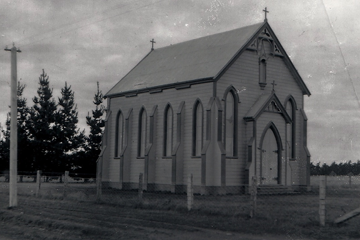In the plan for Waihenga produced by J D Baird in 1870 section 28 Weld Street was set aside for a Scottish Church, 38 Weld Street for an English Church and 6 Grey Street for a Wesleyan Church . No section for a Catholic Church.
However John Martin’s later plan set aside the section which is now the Martinborough Transport corner for a Presbyterian Church, the section where it is now stands for an Anglican Church and what is now 13 Cologne Street for a Catholic Church. Only the Anglican Church took up the offer.
The Wairarapa Standard of 22 June 1880 carried a notice under the Fencing Act instructing the Catholics to erect a dividing fence. With no Catholics in the area at the time Wairarapa’s only priest, Father Halbwachs saw little point in the section and declined it.
By 1894 the number of Catholics now settled in and around Martinborough justified a small wooden church being built. The Martin Estate sold two sections on the corner of Otaraia Road (now Kitchener) and Princess Street. The three acres was considered enough to eventually add a presbytery and school on the site.
This was part of an area originally set aside for a railways station. The turning of the first sod for the railway on the 20th June 1914 was on the next section to the west.
An attractive church was built in 1895 with regular Sunday Mass through until 1918 when on Thursday 10th October it mysteriously burnt to the ground. The church was not connected to the electricity and had not been used for over a week . So, no power short circuit or candle left burning. Insurance for the building totalled four hundred pounds ($41,000)
A strong wave of sectarianism was being stirred up throughout New Zealand at the time and it was suspected that it could have been some misguided person who was responsible. The Wairarapa Daily Times simply noted: “ The Catholic Church in Martinborough was totally destroyed by fire last night. Origin unknown”.
For the next few years Mass was celebrate at the Oddfellows Hall. In 1922 Wellington architect Mr McCosker was contracted to design a church in permanent materials. The then new system of fero concrete (steel reinforced concrete ) was chosen.
Curiously, the building commenced without a contract which proved to be a mistake. Additions had to be made to the original plan , the price of concrete and transport was sky rocketing and the job was held up by wet weather. The money ran out well before the church was finished. At the first wedding, Miss Laura Colman and Mr W O’Connell, tarpaulins borrowed from Chapman were used to keep out the weather.
The unplastered building was blessed by Archbishop O’Shea on 18th Feb 1923. (From a local’s dairy: ‘Nice day. Catholic Church opened. Big gathering of Micks’.)
The plastering was not completed until 1952 at a cost of three thousand pounds ($165,890). The Archbishop was asked for finance but told the parishioners that they had to find the money themselves. The parish led by T Dillon, F Duffy, L McCormack and N Hudson did just that.
Photo caption: the original wooden church.



